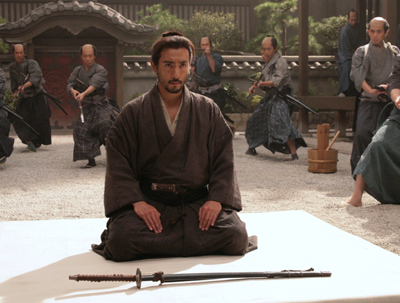 A remake of Masaki Kobayashi's classic Seppuku, which was also called Harakiri. The new movie by Takashi Miike has a 7.2 rating on IMDB, but the original classic had a rating of 8.5, so I don't really get the point of remaking it. A remake of Masaki Kobayashi's classic Seppuku, which was also called Harakiri. The new movie by Takashi Miike has a 7.2 rating on IMDB, but the original classic had a rating of 8.5, so I don't really get the point of remaking it.
The story starts out the same as the first, with a ronin, Hanshiro, coming to a lord's house and asking for a place to commit seppuku. The Lord tells the ronin the fate of another samurai from his clan who had come making the same request.
The lord decided to let the young samurai go through with his request, hoping to dissuade other wandering ronin who were really looking for handouts. The young samurai is a little stunned but begs to be released for a few hours so he can tie things up, but the lords won't allow him to. They shame him into committing seppuku, even though he only has a bamboo sword.
After he is told the story, the samurai is given the chance to leave, but he does not accept it. Before he commits seppuki he asks for a warrior from the house to be his second. He is sent for but doesn't appear. Hanshiro then requests another retainer to be his second but he is missing too. Three of the top retainers are inexplicably missing.
Hanshiro then tells his story, and most of the movie, like the original, is a flashback of the events that proceeded it. It was Hanshiro's son-in-law, Motome, who had come to the castle. Hanshiro then tells the story of Motome, his wife Miho, their child, Kingo, and himself as they struggled, poor but happy.
Motome hears from some villagers of a "suicide bluff" that some young samurais have been performing. They appear at a lord's castle and asks to commit suicide there. The lord takes pity and gives him charity and sends him on his way. When the hard times hit harder, Motome sells his last possessions. When he drops an egg he has bought he eats it off of the ground. Hanshiro also does his best to help provide things for his sick daughter and grandchild. Then Kingo gets sick they can't afford the doctor's fee. Motome leaves but he doesn't return.
Kingo dies and then Motome's body is delivered by the Lord's servants to the grieving Hanshiro and Miho. He had tried the "suicide gamble" to save his family.
The movie then flashes back to the present with Hanshiro in the courtyard, surrounded by the Lord and his retainers. Hanshiro asks if not one of them had the humanity to put themselves in Motome's place. And there you have it. Humanity against the bureaucracy of the bushido code. The code is not always going to be right, there has to be a place for humanity. The other view is that without the code, everything will fall apart.
Hanshiro then recounts how he took the topknots of the Lord's top three retainers who are now hiding in shame. He tells the Lord that honor means nothing. It is "a complete farce." Mike, and Kobayashi before him, are taking the point of view that notions such as duty and honor are used to control a society, often to the detriment of the individuals of that society who unfairly suffer the consequences.
I wasn't wild about the ending. Hanshiro fighting off all the retainers with just a bamboo sword takes the movie to the level of a farce. The samurai code may have been wrong, but the ending went way over the top to try to emphasize it. Sometimes the more subtle approach is more effective.
This movie was the first to be shown at the Cannes Film Festival in 3-D. Seeing it in regular format may actually be unfair to Mike's vision. On its own it is a very good movie. But, if you have seen the original, it pales in comparison.
This is a movie worth seeing, but I would see the original first. There is no reason to dilute the great experience of seeing Seppuku. Then, if you can get this in 3-D, it is might also be well worth seeing.
|